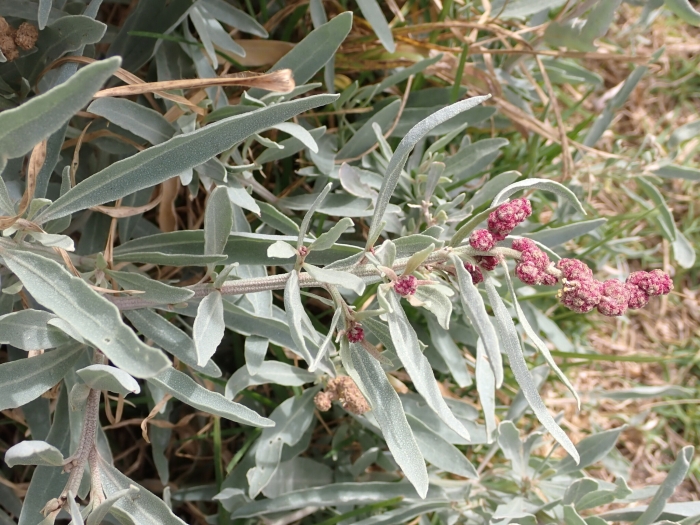Grey Saltbush
(Atriplex cinerea)
Grey Saltbush (Atriplex cinerea)
/
/

naturewatchwidow
CC BY 4.0
Image By:
naturewatchwidow
Recorded By:
Copyright:
CC BY 4.0
Copyright Notice:
Photo by: naturewatchwidow | License Type: CC BY 4.0 | License URL: http://creativecommons.org/licenses/by/4.0/ | Rights Holder: naturewatchwidow | Publisher: iNaturalist | Date Created: 2023-09-23T16:20:32-07:00 |





















Estimated Native Range
Summary
Atriplex cinerea, commonly known as Grey Saltbush or Coast Saltbush, is a perennial shrub native to coastal dunes, saline flats, and salt marsh environments across Australia, including Western Australia, South Australia, Tasmania, Victoria, and New South Wales. It typically grows up to 6 feet (1.8 meters) high and 8 feet (2.4 meters) wide, with a dense, rounded form. The foliage is a distinctive silvery-grey due to the presence of tiny bladder-like hairs, which help the plant manage salt and reduce water loss. Grey Saltbush produces inconspicuous flowers that are generally wind-pollinated.
Grey Saltbush is valued for its exceptional salt and drought tolerance, making it an excellent choice for coastal restoration projects, erosion control, and as a windbreak. It is also used in saline soil reclamation and as a forage plant for livestock in arid regions. In cultivation, it requires minimal care, thriving in full sun and tolerating a range of soil types, including sandy, loamy, and clay soils with poor fertility. It is also highly adaptable to different pH levels, including highly alkaline soils. While it is generally pest and disease-free, it can occasionally suffer from root rot in poorly drained conditions. This plant is not known for being invasive outside its native range.CC BY-SA 4.0
Grey Saltbush is valued for its exceptional salt and drought tolerance, making it an excellent choice for coastal restoration projects, erosion control, and as a windbreak. It is also used in saline soil reclamation and as a forage plant for livestock in arid regions. In cultivation, it requires minimal care, thriving in full sun and tolerating a range of soil types, including sandy, loamy, and clay soils with poor fertility. It is also highly adaptable to different pH levels, including highly alkaline soils. While it is generally pest and disease-free, it can occasionally suffer from root rot in poorly drained conditions. This plant is not known for being invasive outside its native range.CC BY-SA 4.0
Plant Description
- Plant Type: Shrub
- Height: 3-6 feet
- Width: 6-10 feet
- Growth Rate: Moderate
- Flower Color: N/A
- Flowering Season: Spring, Summer
- Leaf Retention: Evergreen
Growth Requirements
- Sun: Full Sun
- Water: Low
- Drainage: Medium, Fast
Common Uses
Drought Tolerant, Erosion Control, Low Maintenance, Salt Tolerant
Natural Habitat
native to coastal dunes, saline flats, and salt marsh environments across Australia, including Western Australia, South Australia, Tasmania, Victoria, and New South Wales
Other Names
Common Names: Grey Saltbush, Gray Saltbush, Coastal Saltbush
Scientific Names: , Atriplex cinerea, Atriplex cinerea f. appendiculata, Atriplex cinerea subsp. eucinerea, Atriplex cinerea subsp. globulosa, Atriplex cinerea var. adamsonii, Atriplex cinerea var. adscendens, Atriplex cinerea var. brachytheca, Atriplex cinerea var. elaeagnoides, Atriplex cinerea var. palmata
GBIF Accepted Name: